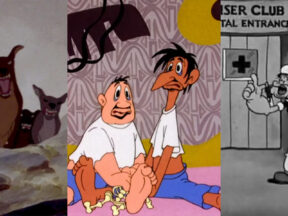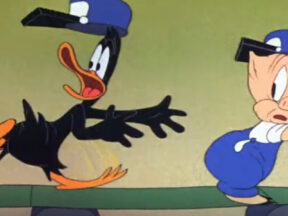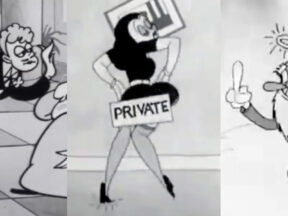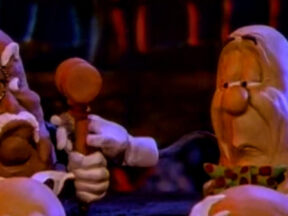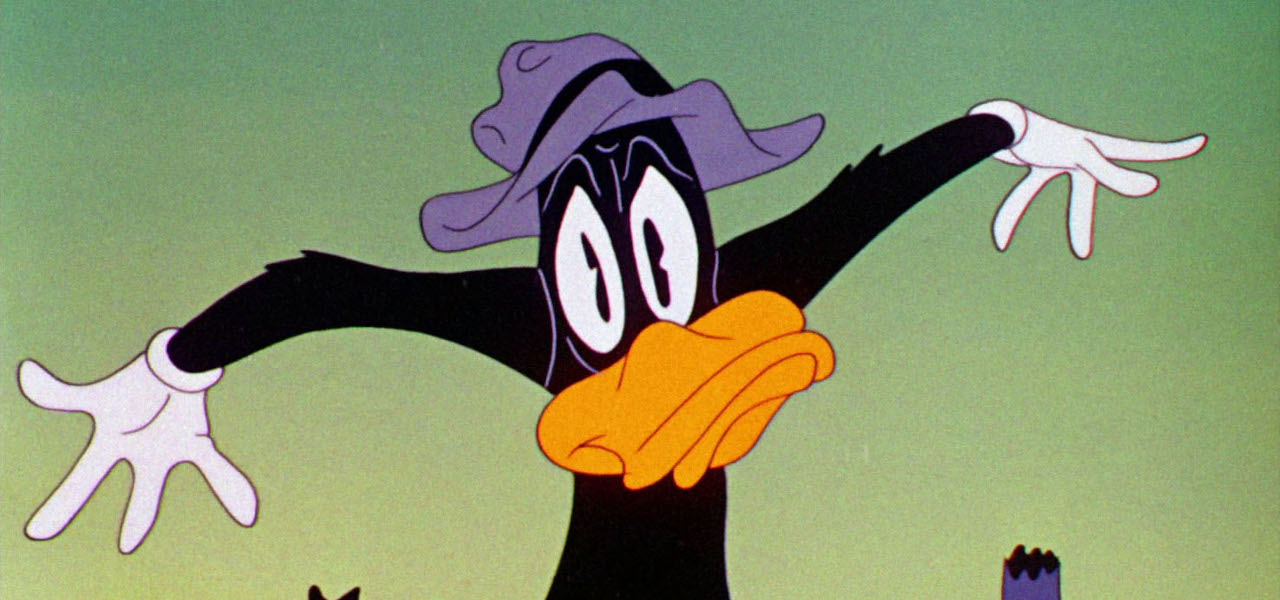
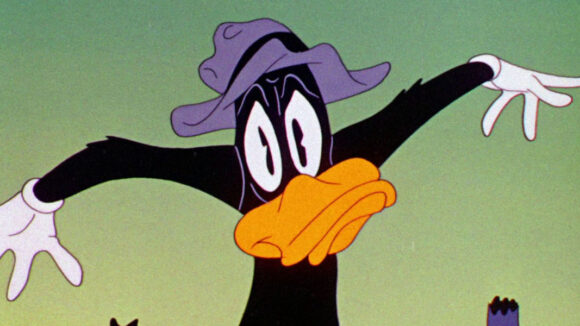
Bob Clampett’s Fifteen Best Freakouts
Bob Clampett – the looniest of the Looney Tunes directors – was born on May 8th, 1913. His cartoons are truly unforgettable for their deranged spurts of hysteria, so to celebrate his 110th birthday, we’re taking a look at the fifteen greatest freakouts in his filmography.
At a time when cute fantasies in the Disney vein were the order of the day, Clampett – along with his fellow Termite Terrace collaborators Tex Avery and Chuck Jones – changed animation forever by pushing cartoons in a faster, funnier direction. Clampett hit the ground running with Porky in Wackyland (1938), one of his earliest directorial efforts and a complete break from the prevailing Silly Symphonies style. This all-time classic is a dizzying burst of defiant nonsense, loaded with surrealistic imagery, off-kilter backdrops, and wacky visual puns. In this sequence, a fourth-dimensional do-do bird goes absolutely bananas on Porky Pig, with delightfully zany results.
— Cartoon Study (@CartoonStudy) May 8, 2023
All of the Warner Bros. directors injected their own personal brand of insanity into their works, but Clampett took things a step farther than the rest; his cartoons aren’t just insane, they’re dangerously insane. His early short The Daffy Doc (1938) is a masterpiece of bad taste. In the film, Daffy Duck goes ballistic in a hospital and finally chases Porky with a giant saw, all without any clear goal or motivation. It would be horrifying if it weren’t so funny.
— Cartoon Study (@CartoonStudy) May 8, 2023
One of my favorite Clampett moments comes from Porky in Egypt (1938), where Humpty Bumpty the camel flips his lid in the desert heat. His complete nervous breakdown is so hilariously intense that it borders on disturbing, aided by impassioned voicework by Danny Webb (who deserved an Oscar nomination for best supporting actor). This scene is a clear predecessor to the unsettling freakouts in The Ren & Stimpy Show. I have no idea what audiences made of it in 1938.
— Cartoon Study (@CartoonStudy) May 8, 2023
Clampett’s early black & white shorts are overflowing with youthful enthusiasm, but he really hit his stride when he took over Tex Avery’s unit in 1941. Armed with a team of animators that could keep up with the hysteria going on in his brain, Clampett developed a totally new approach to animation that he called the “Lichty style” (named after cartoonist George Lichty, whose comic strip Grin and Bear It was noted for its loose, spontaneous drawing style). Clampett wildly distorted his characters’ bodies to express their warped emotional states, particularly in scenes animated by the brilliant Rod Scribner. This explosive Scribner bit from Tortoise Wins by a Hare (1943), in which Bugs Bunny unusually loses his cool, perfectly showcases Scribner’s eccentric approach; look for the weird wrinkles, excess teeth, and rubbery elasticity (animator Robert McKimson takes over at the end for the “and I will, too” line).
— Cartoon Study (@CartoonStudy) May 8, 2023
One of the great Clampett freakouts shows up in The Wise Quacking Duck (1943), where Daffy acts out an aerial battle for no apparent reason. You can’t beat the combination of visual fireworks and Mel Blanc screaming his lungs out on the soundtrack.
— Cartoon Study (@CartoonStudy) May 8, 2023
This short bit from Buckaroo Bugs (1944) is a prime example of Clampett’s talent for expressing emotions in terms that would only be possible in a cartoon. The idea that a horse would turn completely inside out to change direction mid-air feels both totally ridiculous and completely natural. Manny Gould animates the desperate horse.
— Cartoon Study (@CartoonStudy) May 8, 2023
Any clip chosen at random from the WWII cartoon Draftee Daffy (1944) could qualify for this list, as it’s essentially a seven-minute anxiety attack. Daffy’s frantic attempts to escape from the little man from the draft board keep escalating in feverish delirium.
— Cartoon Study (@CartoonStudy) May 8, 2023
One of Clampett’s strangest characters is the blue-skinned Sloppy Moe, who keeps popping up in Wagon Heels (1945). He prances around, gibbering about a secret, and his pent-up psychosis occasionally explodes. That’s Clampett himself doing Moe’s voice.
— Cartoon Study (@CartoonStudy) May 8, 2023
This scene from the classic A Gruesome Twosome (1945) not only boasts top-shelf Clampettian lunacy, but it’s also a brilliant gag that sums up what the Looney Tunes style is all about: it combines funny character acting, smart fourth-wall-breaking humor, and anything-goes absurdity, and it’s pulled off with jaw-dropping artistic expertise. Rod Scribner’s animation of that dog is just bursting with life.
— Cartoon Study (@CartoonStudy) May 8, 2023
One of my favorite scenes in film history is this deliciously weird sequence from Book Revue (1946), in which Daffy Duck (wearing a getup reminiscent of comedian Danny Kaye) issues a frenzied warning to Little Red Riding Hood in the form of a mile-a-minute scat performance. Mel Blanc’s patter-singing is legitimately extraordinary and Daffy vigorously acting it all out is a riot. The giant eyeball that ends the scene – one of the great wild takes in animation history (animated by Bill Melendez) – is the icing on the cake.
— Cartoon Study (@CartoonStudy) May 8, 2023
By 1946, the performances in Clampett’s cartoons were so commanding that they didn’t even need backgrounds. Daffy’s screwball histrionics at the climax of Baby Bottleneck (1946) are set against a featureless gradient, an unusual move in the 1940s. Bill Melendez’s handling of Daffy attempting to run with a stretched-out leg might be the funniest walk cycle ever drawn.
— Cartoon Study (@CartoonStudy) May 8, 2023
I never get tired of watching Clampett’s cartoons, largely because even after you have the jokes memorized, their restless energy is exhilarating. Clampett just packs so much comic invention into every scene; take for example this moment from Kitty Kornered (1946) in which Porky Pig falls to pieces panicking about aliens. There’s so much happening in this, including constant little sight gags and funny lines (“worry, worry”), dazzling compositions (check out that split-second forced-perspective shot of Porky aiming his gun down a warped flight of stairs), and great bits of acting from various animators making no attempt to blend their disparate styles. We also get a taste of Clampett’s fondness for pop-culture references; that stairway bit is a nod to the comedy Arsenic and Old Lace, in which a crazy man who believes himself to be Teddy Roosevelt keeps running up the stairs yelling, “CHAAARGE!”
— Cartoon Study (@CartoonStudy) May 8, 2023
The Great Piggy Bank Robbery (1946) is the pinnacle of Clampett’s directorial career and quite possibly the height of animated filmmaking full-stop. The film plunges us into Daffy’s unbalanced mental state as he dreams about being master detective Duck Twacy. Rod Scribner animates the amazing bit where Daffy talks to himself on the phone; every individual frame of Scribner’s work is totally unique and hilarious, and yet it flows together beautifully.
— Cartoon Study (@CartoonStudy) May 8, 2023
Bacall to Arms (1946) is a film Clampett left unfinished when he departed the studio, so it had to be completed by Art Davis. The final product is a mess, but it has some first-rate Clampett reaction takes. In the film, a wolf erupts with lust at a screening of the Lauren Bacall movie To Have and Have Not. I love the wolf’s maniacal giggling as he huffs that cigarette.
— Cartoon Study (@CartoonStudy) May 8, 2023
Clampett may have taken his demented approach as far as it could possibly go in his final Looney Tunes short, The Big Snooze (1946). In this semi-autobiographical cartoon, Elmer Fudd gets sick of being constantly heckled by Bugs and rips up his contract with Warner Bros. The film then takes us into Elmer Fudd’s head to see up close how Bugs Bunny has driven him stark-raving bonkers. It’s a fantastic send-off for Clampett, and the psychedelic imagery is years ahead of its time.
— Cartoon Study (@CartoonStudy) May 8, 2023
And that’s the list. What are your favorite Clampett moments? Let us know in the comments below. That’s all, folks!
— Cartoon Study (@CartoonStudy) May 8, 2023
Thanks to Keith Scott and Devon Baxter.

